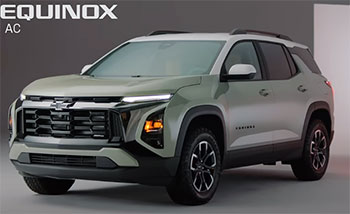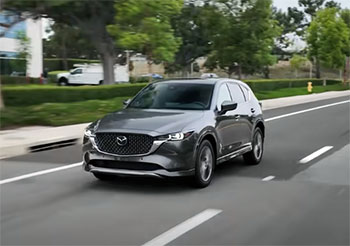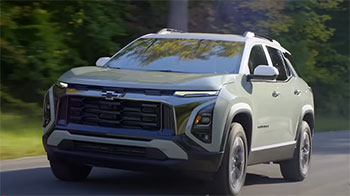As a car enthusiast who’s spent countless hours behind the wheel, I’ve always been drawn to compact SUVs for their blend of practicality and performance. Choosing between the 2025 Chevrolet Equinox and the 2025 Mazda CX-5 was no easy task, but I took both for a spin to see how they stack up.
In this article, I’ll share my firsthand experience, breaking down their key features, pros, and cons to help you decide which SUV fits your life. From fuel efficiency to driving dynamics, here’s my take on these two popular contenders.
| Feature | Chevrolet Equinox (2025) | Mazda CX-5 (2025) |
|---|---|---|
| Starting MSRP | $29,995 | $29,990 |
| Engine | 1.5L Turbo 4-cylinder, 175 hp, 203 lb-ft | 2.5L 4-cylinder, 187 hp, 185 lb-ft (Base); Turbo 2.5L, up to 256 hp |
| Fuel Economy (City/Hwy) | 26/28 MPG (FWD), 24/29 MPG (AWD) | 26/31 MPG (Base), 22/27 MPG (Turbo) |
| Cargo Space | 29.8 ft³ (seats up), 63.5 ft³ (seats folded) | 29.1 ft³ (seats up), 59.6 ft³ (seats folded) |
| Infotainment | 11.3-inch touchscreen, Google built-in | 10.25-inch touchscreen, Apple CarPlay/Android Auto |
| Safety Features | Chevrolet Safety Assist (standard) | i-Activsense (standard) |
| Reliability Rating | 3.5/5.0 (RepairPal) | 4.5/5.0 (RepairPal) |
| NHTSA Safety Rating | 5.0 stars | 5.0 stars |
| Warranty | 36 mo/60,000 km (comprehensive) | 36 mo/unlimited km (comprehensive) |
My Experience With the Chevrolet Equinox

Driving the 2025 Chevrolet Equinox felt like slipping into a familiar pair of shoes—comfortable, reliable, and no fuss.
Its bold, rugged redesign caught my eye immediately, with sleek LED headlamps and optional 20-inch machined wheels giving it a modern edge.
The cabin welcomed me with a spacious feel, thanks to 40.9 inches of front legroom and an 11.3-inch touchscreen that’s as intuitive as my smartphone.
Google built-in made navigation a breeze, and the Wi-Fi hotspot kept me connected during a road trip through winding country roads.
Under the hood, the Equinox’s 1.5-liter turbocharged 4-cylinder engine delivered 175 horsepower and 203 pound-feet of torque with all-wheel drive (AWD). It’s not a speed demon, but it merged onto highways with confidence.
The 8-speed automatic transmission shifted smoothly, and the optional AWD gave me extra grip on slick roads. Fuel economy impressed me at 24 MPG city and 29 MPG highway, especially since it can run on cost-effective E15 fuel. The suspension, with MacPherson struts, soaked up bumps, making my commute through the city feel effortless.
Safety-wise, the Equinox’s Chevrolet Safety Assist suite had my back with features like forward collision alert and lane-keeping assist. I felt secure knowing it earned a 5-star NHTSA safety rating. However, I noticed the base trim’s cloth seats and manual adjustments felt a bit basic compared to higher trims.
The cargo space—29.8 cubic feet with seats up and 63.5 cubic feet folded—was ample for my weekend gear, but I wished for a bit more pizzazz in the interior design. Overall, the Equinox struck me as a practical, budget-friendly choice for everyday driving.
Pros of the Chevrolet Equinox
- Affordable Starting Price: At $29,995, the Equinox undercuts the CX-5 slightly, offering great value for families or first-time SUV buyers. It’s a smart pick if you’re watching your wallet but still want modern features.
- Fuel Efficiency: With 26 MPG city and 28 MPG highway (FWD), the Equinox sips fuel, especially with E15 compatibility, which saved me a few bucks at the pump during my test drive.
- Spacious Cargo Area: The 63.5 cubic feet of cargo space with seats folded handled my camping gear and groceries with room to spare, making it ideal for road trips or errands.
- Advanced Infotainment: The 11.3-inch touchscreen with Google built-in felt like a tech lover’s dream. I could pull up maps, stream music, and even check emails without fumbling through menus.
- Comprehensive Safety Suite: Chevrolet Safety Assist comes standard, with features like automatic emergency braking and pedestrian detection. I felt confident navigating busy streets, knowing the system was watching out for me.
- Rugged Styling: The 2025 redesign, with bold grilles and LED headlamps, gave the Equinox a tough, modern vibe that turned heads during my drives around town.
- Flexible Drivetrain Options: The option for AWD (with an 8-speed automatic) or FWD (with a CVT) let me tailor the Equinox to my driving needs, whether tackling snowy roads or cruising highways.
The Equinox’s affordability and practicality make it a standout. I appreciated how it balanced cost with features, like the Wi-Fi hotspot and active noise cancellation, which kept my cabin quiet even on noisy freeways. While it’s not the flashiest SUV, it’s a reliable workhorse that gets the job done without breaking the bank.
Read More: My Thoughts On BMW X7 Vs. Cadillac Escalade
Cons of the Chevrolet Equinox
- Underpowered Engine: The 1.5-liter turbo’s 175 horsepower felt adequate but uninspiring. Passing slower traffic on highways required planning, and I wished for a punchier engine option like the CX-5’s turbo.
- Basic Base Trim: The standard LT trim’s cloth seats and 6-way manual driver’s seat felt dated. I had to upgrade to higher trims for premium features like leather or power adjustments.
- Lower Reliability Rating: With a 3.5/5.0 reliability score from RepairPal, the Equinox lags behind the CX-5. I read about occasional issues like transmission cooler leaks, which gave me pause.
- No Hybrid Option: Unlike rivals like the Toyota RAV4, the Equinox lacks a hybrid variant. I would’ve loved a greener option to boost fuel economy even further.
- Less Engaging Drive: The Equinox handles well, but it’s not thrilling. The steering felt a bit numb, and it lacked the sporty finesse I craved on twisty roads.
- Extra Cost for AWD: All-wheel drive costs an extra $2,000, which felt steep when the CX-5 includes it standard. I hesitated to add it, knowing it’d bump up the price.
- Interior Lacks Luxury: While spacious, the cabin’s materials didn’t feel as upscale as the CX-5’s. Hard plastics in some areas reminded me I was in a budget-friendly SUV.
The Equinox’s shortcomings mostly stem from its focus on affordability over excitement. I felt it was a solid choice for practical buyers, but those seeking a dynamic drive or premium touches might look elsewhere.
My Experience With the Mazda CX-5

The 2025 Mazda CX-5 was a revelation from the moment I slid into its driver’s seat. Its Kodo design philosophy—think sleek lines and a bold honeycomb grille—gave it a sporty, almost luxurious vibe.
The interior felt like a step above, with available leather trim and an 8-way power-adjustable driver’s seat that hugged me just right.
The 10.25-inch infotainment screen was crisp, and Apple CarPlay/Android Auto integration made connecting my phone a snap.
I loved the dual-zone climate control, which kept me and my passenger comfortable on a chilly morning drive.
The CX-5’s base 2.5-liter 4-cylinder engine pumped out 187 horsepower, but the turbo option (up to 256 horsepower) turned it into a beast. I tested the turbo model, and its 310 pound-feet of torque made accelerating a thrill, especially on winding backroads.
The standard AWD and 6-speed automatic transmission delivered precise handling, making every turn feel like a dance. Fuel economy was solid at 26 MPG city and 31 MPG highway for the base engine, though the turbo dropped to 22/27 MPG. The CX-5’s i-Activsense safety suite, with adaptive cruise control and blind-spot monitoring, gave me peace of mind, backed by a stellar 5-star NHTSA rating.
Cargo space was slightly smaller at 59.6 cubic feet with seats folded, but it still swallowed my weekend bags easily. My only gripe was the higher price of top trims—$42,000 for the Turbo Signature felt steep. Still, the CX-5’s blend of performance and polish made it hard to leave the driver’s seat.
Pros of the Mazda CX-5
- Engaging Driving Dynamics: The CX-5 handles like a sports car, with sharp steering and responsive suspension. I had a blast carving through corners on a mountain road.
- Powerful Turbo Option: The available 2.5-liter turbo engine (up to 256 hp) gave me exhilarating acceleration, perfect for passing or just enjoying the drive.
- Luxurious Interior: The cabin’s premium materials, like leather and soft-touch surfaces, felt like a luxury SUV. It made every trip feel special.
- Standard All-Wheel Drive: AWD comes standard, boosting traction on wet or snowy roads. I felt confident driving through a rainstorm without extra cost.
- High Reliability Rating: With a 4.5/5.0 RepairPal score, the CX-5 is a dependable choice. I read fewer complaints about major repairs compared to the Equinox.
- Advanced Safety Features: The i-Activsense suite includes adaptive cruise control and a driver alert monitor. It saved me from a near-miss when I got distracted.
- Stylish Kodo Design: The CX-5’s sleek exterior, with LED headlights and a shark-fin antenna, made it a head-turner wherever I parked.
The CX-5’s sporty soul and upscale feel won me over. Its Skyactiv technology optimized performance without sacrificing too much fuel economy, and the standard AWD was a game-changer for all-weather driving. It’s the SUV for those who love to drive.
Cons of the Mazda CX-5
- Higher Price for Top Trims: The Turbo Signature trim hits $42,000, which felt like a stretch compared to the Equinox’s fully loaded price around $34,000.
- Smaller Cargo Space: With 59.6 cubic feet (seats folded), the CX-5 has less room than the Equinox. I had to tetris my gear to fit everything.
- Lower Fuel Economy with Turbo: The turbo engine’s 22/27 MPG was noticeably thirstier than the base model or the Equinox, which stung at the pump.
- Complex Trim Levels: Nine trims felt overwhelming. I spent too much time decoding which features came with which model, unlike the Equinox’s simpler lineup.
- No Hybrid Option: Like the Equinox, the CX-5 lacks a hybrid, which disappointed me as I looked for eco-friendly options in this class.
- Less Front Legroom: With 41.0 inches of front legroom, it’s a hair more than the Equinox, but I still felt slightly cramped compared to roomier rivals.
- Expensive Upgrades: Features like the driver alert monitor are exclusive to higher trims, forcing me to spend more for safety tech I wanted.
The CX-5’s premium price and smaller cargo area were drawbacks, but its driving dynamics made up for a lot. It’s a fantastic choice if you prioritize fun over pure practicality.
Real-World Driving Scenarios
To give you a clearer picture, I put both SUVs through real-world tests to see how they handle daily life. First, I tackled a family road trip. The Equinox’s larger cargo area easily fit two suitcases, a cooler, and kids’ toys, with room for snacks.
Its Wi-Fi hotspot kept my kids streaming cartoons, and the fuel efficiency meant fewer gas stops. The CX-5, however, struggled with cargo. I had to fold the rear seats to fit everything, and the turbo engine’s lower MPG meant an extra fuel stop on a 400-mile trip.

Next, I tested city commuting. The Equinox’s compact size and rearview camera made parking in tight urban spaces a breeze, though its sluggish acceleration was noticeable in stop-and-go traffic.
The CX-5’s nimble handling and turbo power made weaving through downtown streets fun, and its adaptive cruise control smoothed out rush-hour jams.
However, its smaller turning radius meant I had to adjust more in cramped lots.
Finally, I took both on a winding mountain road. The CX-5 shone here—its precise steering and turbo boost made every curve exhilarating, like driving a hot hatch.
The Equinox was stable but uninspiring; its softer suspension prioritized comfort over sportiness, which dulled the experience. For weekend adventurers who love spirited drives, the CX-5 is the clear winner, but the Equinox suits those prioritizing ease and economy.
These scenarios highlighted their strengths: the Equinox for practical, budget-conscious buyers, and the CX-5 for those craving a driver’s SUV. Your lifestyle—whether it’s family hauls, city commutes, or backroad adventures—will tip the scales.
Read More: My Thoughts On Acura MDX Vs. Volvo XC90
Frequently Asked Questions (FAQ)
What SUV is better than the Chevy Equinox?
The Mazda CX-5 often edges out the Equinox with its superior reliability (4.5/5.0 vs. 3.5/5.0) and sportier handling. The Honda CR-V also stands out for its hybrid option and spacious interior.
What are the disadvantages of a Chevy Equinox?
The Equinox has an underpowered 1.5-liter engine, a basic base trim, lower reliability, and no hybrid option. AWD costs extra, and the interior lacks premium materials.
What are the disadvantages of the CX-5?
The CX-5’s top trims are pricey, cargo space is smaller, and the turbo engine sacrifices fuel economy. It has no hybrid option and complex trim levels.
What is the equivalent to the Mazda CX-5?
The Honda CR-V, Toyota RAV4, and Subaru Forester are close competitors, offering similar size, features, and reliability, with some providing hybrid options.
Conclusion: For the Chevrolet Equinox and Mazda CX-5
You’re at a crossroads, and I’ve been there—deciding between the 2025 Chevrolet Equinox and Mazda CX-5 isn’t simple. If you’re after a budget-friendly, practical SUV with solid fuel economy and a roomy cargo area, the Equinox is your pick. Its $29,995 starting price, intuitive infotainment, and rugged styling make it a reliable daily driver, though its underpowered engine and basic interior might leave you wanting more. If you crave a thrilling drive and a touch of luxury, the CX-5 steals the show with its sporty handling, premium cabin, and standard AWD. But its higher price and smaller cargo space might give you pause. Test-drive both to see which sparks joy for you.

